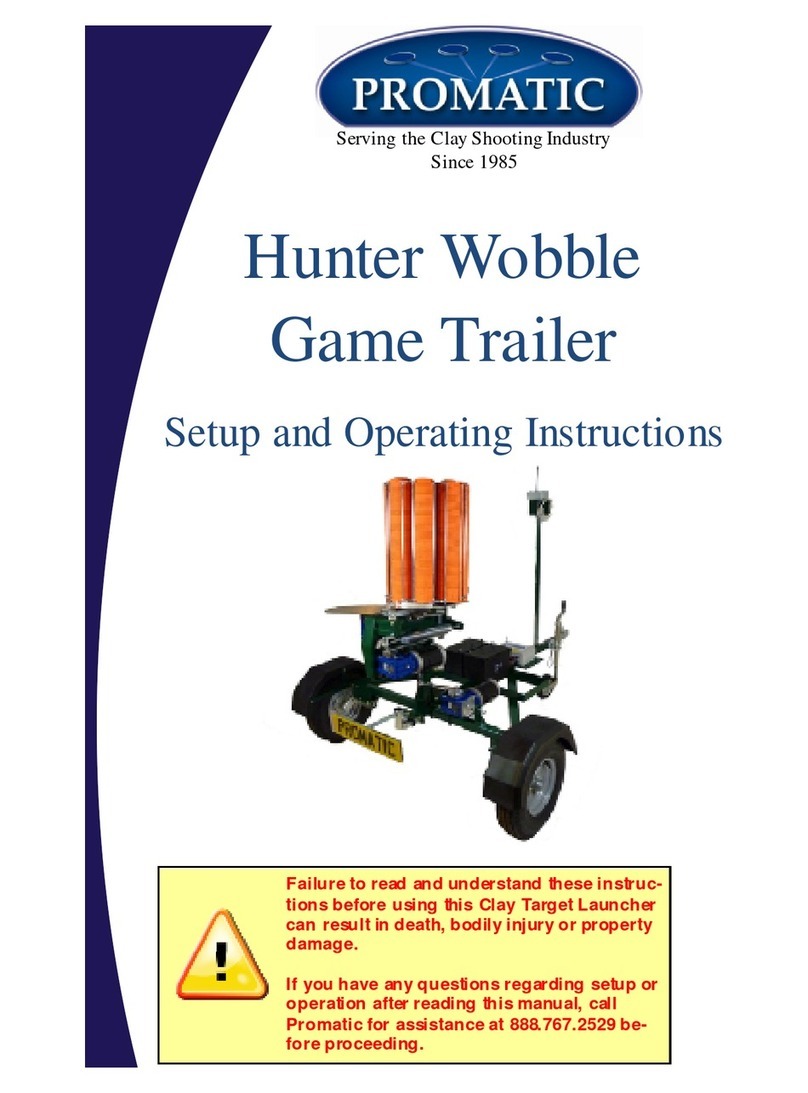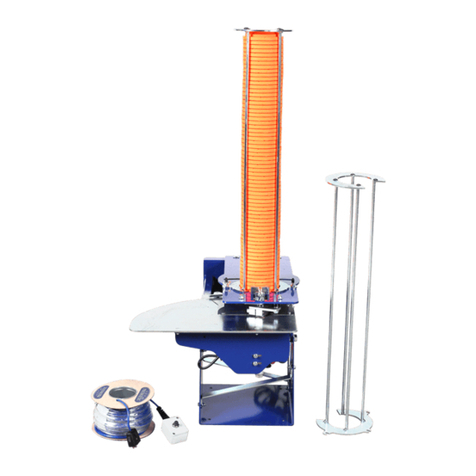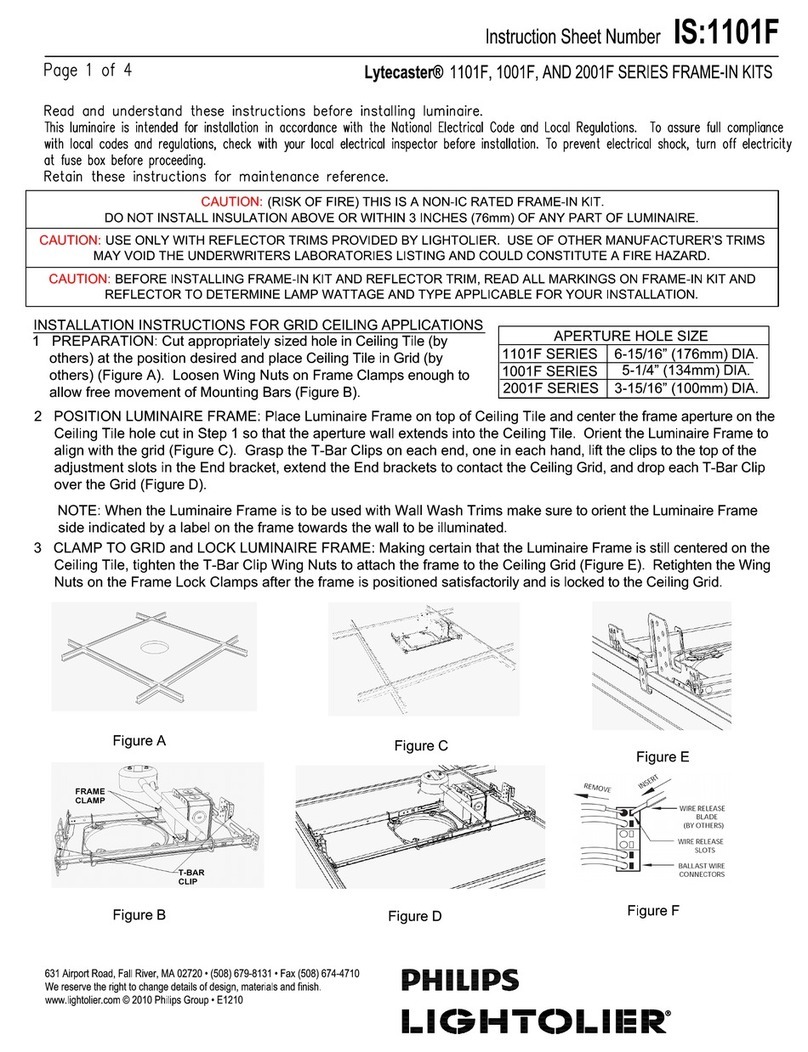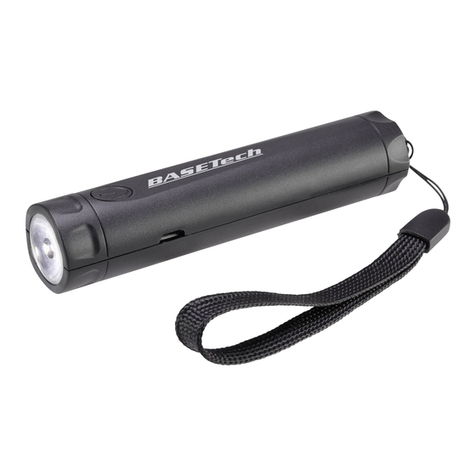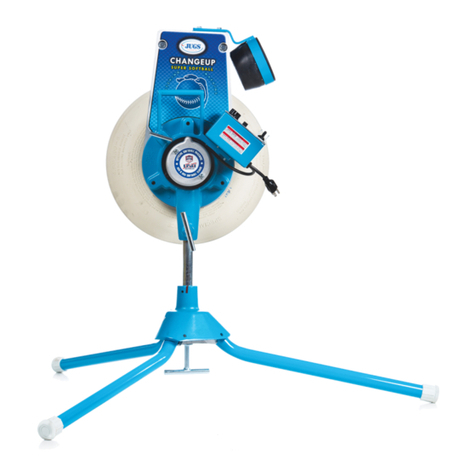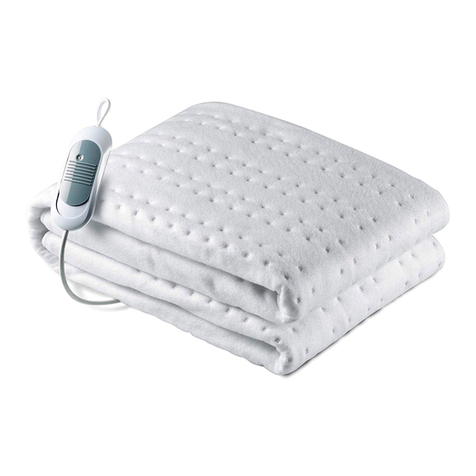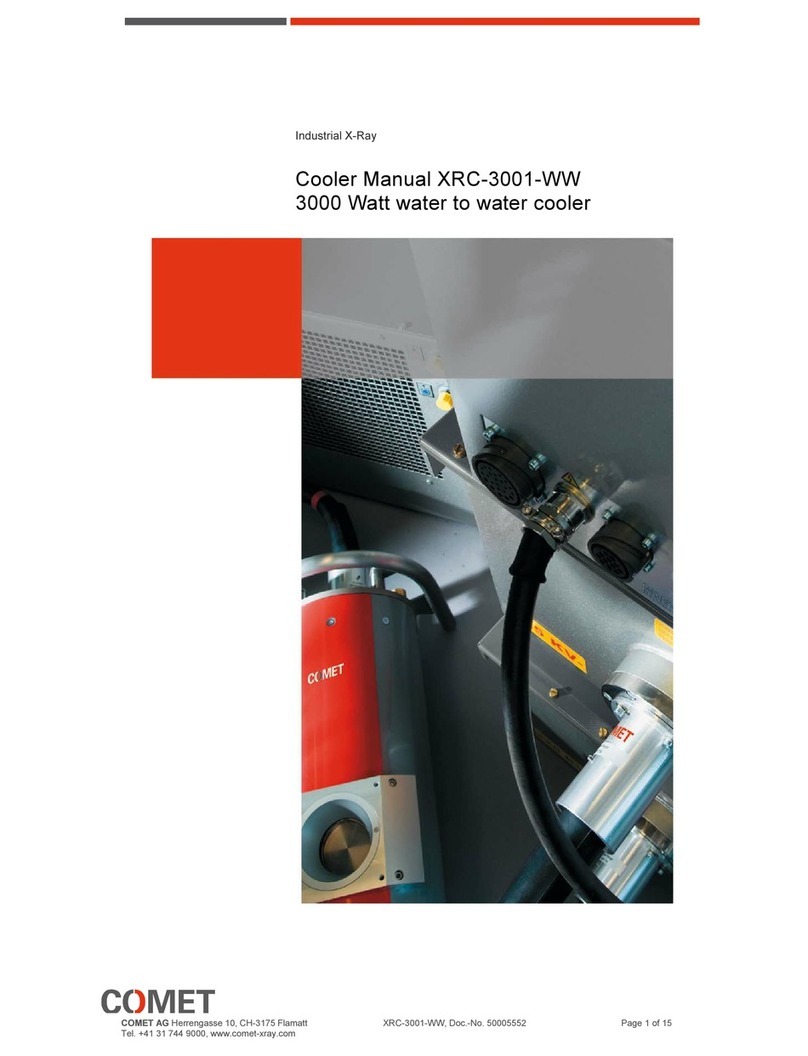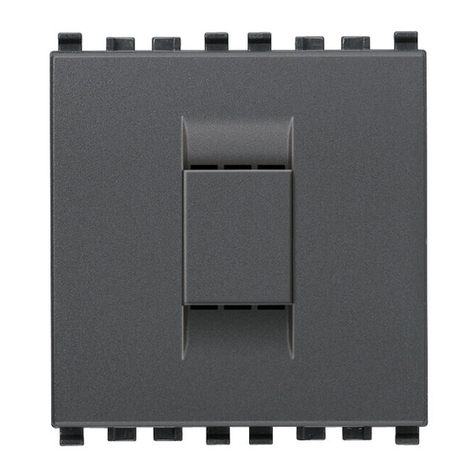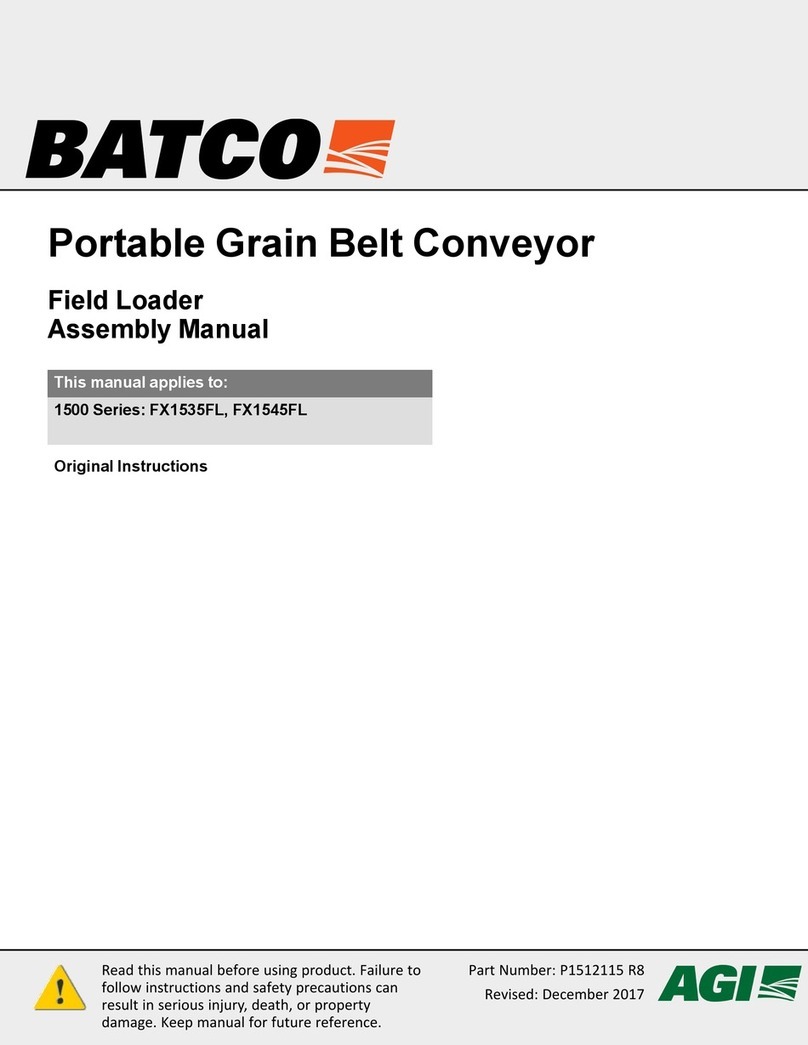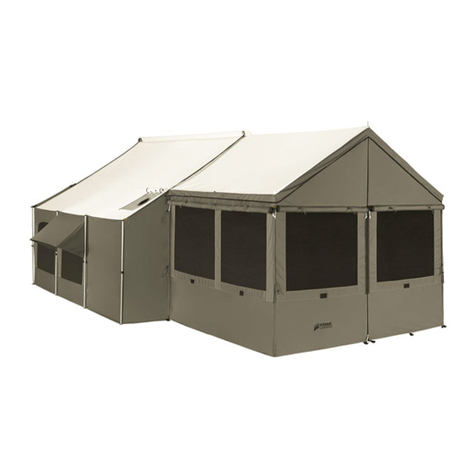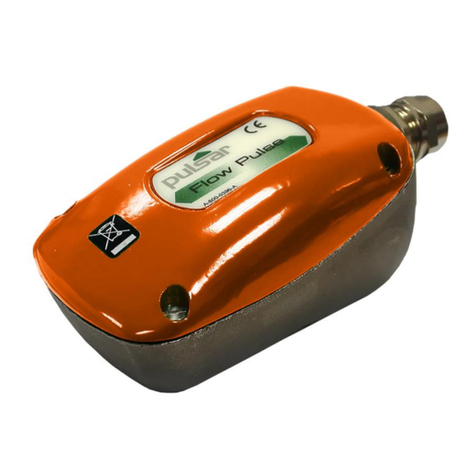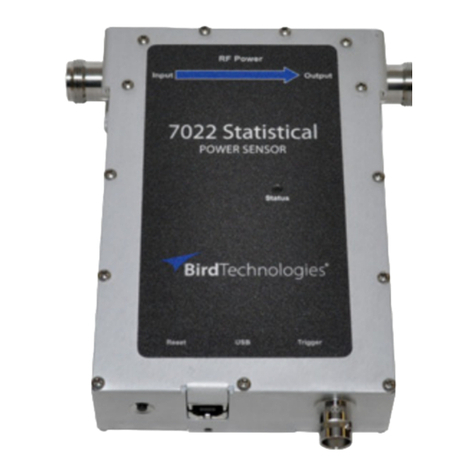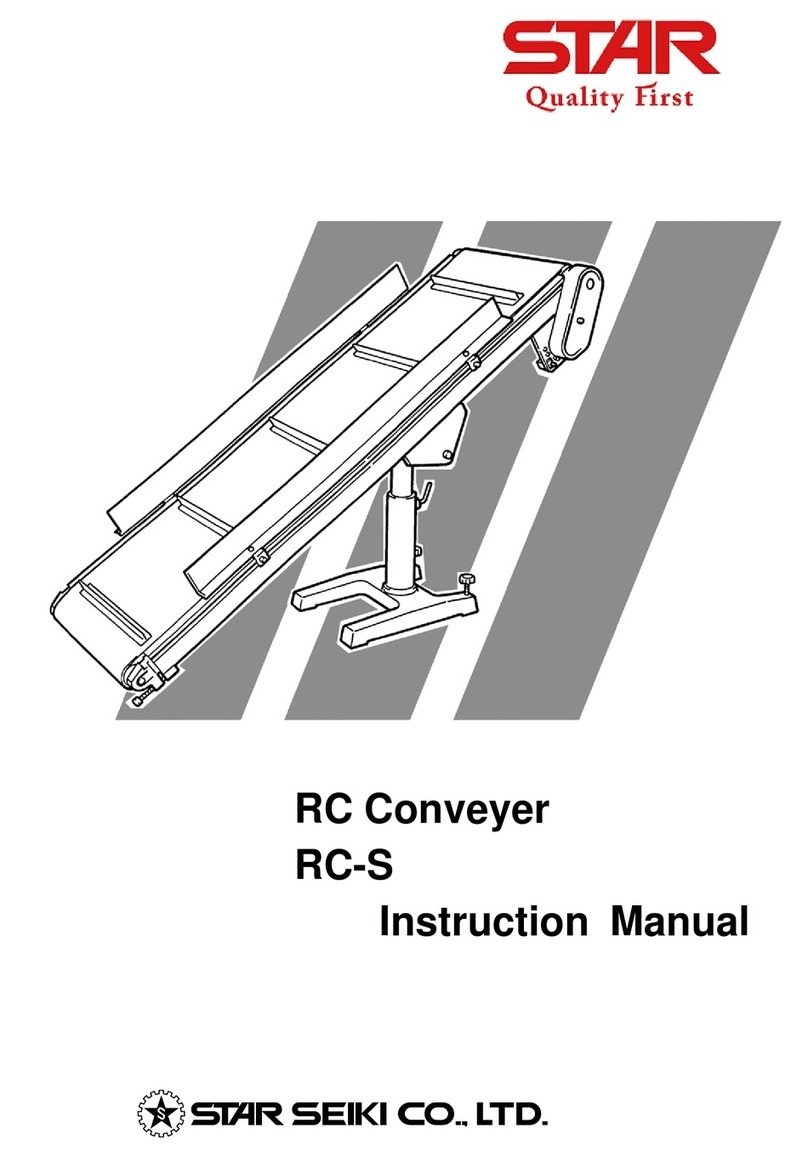Promatic Hobby User manual

Operang Instrucons
Hobby - Clay target launcher
This document must be read in full before aempng to operate the machine
WARNING
Clay target launchers can be dangerous and must be
treated with great care at all mes to avoid accidents.
Never place any bodily part into the path of any me-
chanical piece whilst the machine is in moon or likely
to be so.
You must treat a clay target launcher with the same
cauon that you would treat a loaded gun.
Assume at all mes that a clay target launcher is
armed and loaded and treat it accordingly
Specicaons:
Single column 55 target hopper.
Weight: 34.5kg / 76 lbs
Length: 490mm / 19 ¼“
Width: 420mm / 16 ½ “
Height: 940mm / 37” (On lt base)
Power: 12vDC Rechargeable baery

2
Preface:
Every eort has been made to ensure that the informaon contained within this
manual is complete, accurate and up-to-date. Promac Internaonal assumes no
responsibility for errors beyond its control.
Convenons used within this manual:
Trap: Your Hobby - Clay target launcher—commonly known as a clay trap and may
be referred to in this manual as “The trap” or “The machine”
Warnings & Cauons:
Warning: This secon contains instrucons which, if ignored or carried
out incorrectly, may result in risk of personal injury.
Cauon: This secon contains instrucons which, if ignored or carried
out incorrectly, may result in malfuncon or damage to the equipment
Note: This secon contains addional informaon which the user may
nd useful, but is not essenal to the operaon of the product.
EYE PROTECTION MUST BE WORN WHEN
WORKING ON OR AROUND A CLAY TARGET
LAUNCHER AS SMALL SHARP PIECES OF CLAY
MAY BE EJECTED DURING NORMAL USE.
12v DC Power Source:
This product is designed to be powered from a
12v DC baery, it SHOULD NOT BE DIRECTLY
CONNECTED TO HOUSEHOLD AC POWER
Baery: Where a trap is connected to any other
suitable power source i.e. a Transformer - the
relevant secons of instrucons should sll be
observed, i.e. “Disconnect the baery” and ap-
plied to this or any other power source.

3
Hopper
Elevaon Adjustment
Handwheel
Hopper Mounng
screws
Plunger
Roller Switch
Main Sha
Spring
Motor
Casng Plate
Throwing Arm
Spring Adjustment
Handwheel
Gearbox block
Understanding your new trap:

4
Connecng the baery:
Ensure you are behind the machine, the ARM/DISARM switch is in the OFF posion
and it is otherwise safe to proceed. Connect the red cable to the Red (+) terminal
and the black cable to the Black (-) Terminal. Ensure the terminal fasteners are
ght, the baery is securely strapped to its tray and the charger has been removed.
Never approach the machine from the front or sides, Do not assume
the trap is safe even without electrical power it may sll be armed.
Electrical Troubleshoong :
Trap fails to re-arm - aer a period of prolonged use the trap fails to re-arm itself
and is found to be stalled (may also be making a humming sound) then this is an
indicaon that the baery is depleted, and the voltage has fallen too low to oper-
ate the trap. Disconnect the baery immediately and re-charge (or t a replace-
ment fully-charged baery).
Although the baery may appear to have recovered, the trap should not be used
any further than necessary to make it safe as this may cause damage to the motor,
Baery or other electrical circuits.
Trap res by itself - Disconnect any external cable and switch the trap back on. If
the trap arms normally then the command cable is faulty. If the trap connues to
re, switch the machine o and disconnect the baery. Check the roller switch is
moving freely and an audible click can be heard when it is moved. Re-test the ma-
chine. If the machine sll res by itself then the Roller switch is faulty and must be
replaced.
Circuit breaker has operated - The baery may have been incorrectly ed
(terminals reversed) or an excessive amount of current was drawn either due to a
fault or obstrucon within the trap.
If the circuit breaker has tripped due to an obstrucon DO NOT AS-
SUME THE TRAP IS SAFE it may sll be armed with the obstrucon
holding back the energy from the spring - carefully clear the obstruc-
on whilst remaining in the safe area behind the trap BE AWARE of
the path of the throwing arm AND the debris that may be ejected.

5
Ensure the machine is stable on rm level ground before use.
Bolt the machine to a solid base or the Oponal Trolley Base.
ALWAYS disarm the machine before any loading, adjustment or maintenance.
ALWAYS load clays from rear and ONLY if the machine is disarmed and safe.
NEVER approach the machine from the front or sides. ALWAYS from the rear.
NEVER allow children or untrained persons to approach or touch the machine.
NEVER move an armed/loaded machine. ALWAYS disarm and disconnect baery.
REMOVE the main throwing spring before Transport in a vehicle.
BE AWARE of the fall zone of both broken and unbroken clays and that a change in
wind direcon will aect this.
Posioning the machine
1. Clay Target Launchers must be situated on rm level ground in a posion that
will allow unrestricted access to rear of machine.
2. There must be no obstrucons to the path of the throwing arm.
3. Ensure that the power supply can be easily disconnected and cables cannot
become tangled in any part of the mechanism.
Firing the machine
1. Turn the ON/OFF or switch (if ed) to the ON or posion and set
the ARM/DISARM switch to the ARM/LOAD posion. The machine will
move automacally and arm itself ready to launch a loaded clay.
2. Press the FIRE buon on the command cable to throw a clay.
3. The machine will re every me the FIRE buon is pressed and will auto-
macally rearm itself, unl disarmed and switched o or disconnected.
Disarming the machine
1. To disarm the machine push the ARM/DISARM switch upwards to the DIS-
ARM posion and immediately release (long enough for the trap to re, but
not giving the machine a chance to rearm).
2. Turn the ON/OFF or switch (if ed) to the ON or posion and dis-
connect the baery.

6
Safe Mode Procedure - Warning: Stand at rear of machine only
1. Disarm the machine by icking the ARM/DISARM switch upwards towards the
DISARM posion and immediately releasing (long enough for the trap to re, but
not giving the machine a chance to rearm). The Gearbox block (A rectangular
block aached to the gearbox sha) should stop in a posion poinng towards
the front of the machine.
2. If the Gearbox block is poinng directly towards the front of the machine, push
the ARM/DISARM switch momentarily in direcon of DISARM/NUDGE just
enough to allow the block past its forward poinng posion.
3. If the block has gone too far, rearm the machine and then disarm again unl
the desired posion is achieved.
4. Disconnect the baery/power source from the machine once the block is in
the correct posion.
5. With the Gearbox block now poinng just past the forward poinng posion,
the throwing arm can be pushed slowly, USING THE PALM OF THE HAND ONLY,
around counter clockwise .
6. As the throwing arm gets to the ring posion (poinng direct to the back of
the machine) the spring will take over, at which point the drive bolt on the Gear-
box block stops the arm, and prevents it from ring.
This is SAFE MODE the arm is now trapped between the drive bolt in one direc-
on and locked on the one-way bearing within the trap, it cannot move or re-
lease again unl power is applied and the ARM/DISARM switch operated.

7
Adjustment: Plunger Mechanism
As the arm rotates, the plunger presses gently
on the outer rim of the remaining clay stack to
hold it as the boom clay is released from the
iris plates. With the trap at rest and the clays
pushed towards the two rear hopper rods there
should be a visible gap between the second clay
up in the stack and the red polyurethane plung-
er p.
The plunger gap should be around 2mm (1/16")
and can be adjusted if required using two 10mm
spanners/wrenches. Holding the half nut
(located against the back of the brass plunger)
adjust the rear locking nut clockwise to increase
the gap or an-clockwise to decrease it.
Adjustment: Elevaon
Seng Elevaon angle
Trajectory of clays are from
approximately 26 - 50 degrees.
Loosen handwheel nut as shown,
lt to desired angle, re-ghten
handwheel .
ALWAYS disarm the machine before carrying out loading, adjustment or
maintenance.
Be aware that if machine is already lted upwards, when the hand-
wheel is subsequently undone the machine will jolt forward. Support
the weight of the machine from the top of the clay hopper when ad-
jusng the elevaon angle.

8
Adjustment: Spring Tension
Spring adjustment is always easier if the spring aachment point is at its rearmost
posion, this relieves the spring of a large proporon of it’s tension making adjust-
ment much easier as well as reducing wear on the spring adjustment mechanism.
To achieve this, rst perform the Safe Mode Procedure (see page 6) to put the ma-
chine into safe mode and then nudge forward unl the throwing arm projects for-
ward from the front of the machine. At this point stop nudging and disconnect the
baery.
Decrease tension—Using the handwheel loosen spring to desired posion. Hand
ghten inside nut to back of frame and clamp with a further turn of the handwheel.
Increase tension—Loosen handwheel one turn, then adjust the inner nut to allow
the spring room to pull back. Using the handwheel ghten spring to desired posi-
on. Hand ghten inside nut to back of frame and clamp with a further turn of the
ALWAYS disarm the machine before carrying out loading, adjustment or
maintenance.
Important: leave 30mm (1 3/16”) thread length
between inside nut and spring coil. Increasing
spring tension up to full length of thread will seri-
ously detriment the performance of the machine
and will cause spring damage or failure.

9
Crank arm
Arm clamp block bolt
(under throwing arm)
Timing posion
(Over bolt)
WARNING BEFORE ADJUSTMENT (Arm ming)
Part of this procedure requires you to work very close to the trap - before
proceeding be sure you understand and have pracsed the procedure for
pung the trap into safe mode (this can be found on page 6 of this manu-
al) and fully understand when the trap is safe and when it is not.
Adjustment: Throwing arm ming
Perform the Safe Mode Procedure, Using the Disarm/Nudge buon
move the motor crank arm to a posion just past the straight ahead po-
sion. If the block goes too far, rearm the machine (re it) and then dis-
arm again, repeang the procedure unl the desired posion is
achieved. (The ideal posion is such that when the spring crank arm is
poinng straight ahead, the motor crank prevents any further move-
ment of the arm.) Push the Throwing arm around unl the spring crank
arm points directly forward.
Disconnect the baery at this point. Loosen the arm clamp block and
rotate the arm so the front of the yellow fricon strip lines up with the
centre of the second bolt head on the gull wing bracket (on the Merlin)
(The right hand bolt head when viewed from the rear of the machine)
Re-ghten the arm clamp block rmly. Your trap is now correctly med.

10
Spare Parts List:
For parts not listed please call Promatic or you local dealer or visit
www.promaticpartsusa.com
HOPPER
(UK clay)
CAR/B9
HOPPER
(USA clay)
CAR/B10
ROLLER LIMIT
SWITCH
E11V/83850
MOTOR & GEARBOX
M01V/50492E
MAIN SPRING
S01Z/FFLY
MAIN SHAFT
HB/2600
LEFT IRIS
EL/3550
RIGHT IRIS
EL/3600
BRASS PLUNGER
C/W SOFT TIP
HK/1200
HARDENED
IRIS LINKSGE
CAM HB/3625
HARDENED
ARM LINKAGE
CAM HB/2405
UPPER
BACKRAIL
A28A/CUTO
CASTING PLATE
HB/3100
THROWING ARM
HB/2010
BACK RAIL
HR2/3440
SOFT FALL PLATE
A28S/PAFQ
BATTERY 22Ah
SEALED AGM TYPE
E30V/SLC22
PLASTIC KNOB
D01V/100513
SPRING BUSH
HB/2635

11

12
Promatic International Ltd.
Station Works,
Hooton,
South Wirral
CH66 7NF,
United Kingdom.
Tel: +44 (0) 151 327 2220 (General)
+44 (0) 1407 860800 (Sales)
Fax: +44 (0) 151 3277075
E-mail in[email protected].uk
Website: www.promatic.co.uk
Promatic Inc.
801 MID AMERICA DRIVE
PLATTSBURG, MO 64477
USA
Toll Free: 888.767.2529
Fax: 816.539.0257
E-mail: [email protected]
Website: www.promatic.biz
Hobby Version 1.4 July 2013
Table of contents
Other Promatic Accessories manuals
